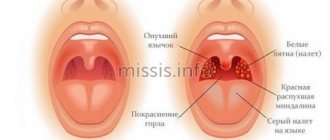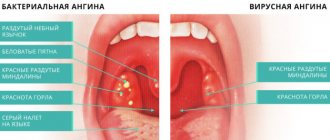Drug treatment of tonsillitis
In most cases, the disease can be successfully treated at home if you strictly follow all the doctor’s instructions for taking medications and observing bed rest.
Initially, the doctor must prescribe a medicine aimed at eliminating the causative agent of bacterial tonsillitis, and also recommend treatment that will alleviate the symptoms of the disease.
The causative agents of the disease are streptococci, staphylococci, Haemophilus influenzae, pneumococci, etc.
Antibiotics
Quite often, the doctor prescribes protected penicillins, which have good absorption and bioavailability, and also have minor side effects.
Such drugs include Amoxiclav, Augmentin, Flemoklav Salutab, etc. All these medications are based on amoxicillin with clavulonic acid.
Macrolide antibiotics are also used: Azithromycin, Sumamed; cephalosporins: “Cefamandol”, “Cefazolin”; lincosamides: Clindamycin.
Antiseptics
Bacterial tonsillitis should be treated at home using topical antiseptics to treat the tonsils.
Antiseptics can be produced in various forms:
- Sprays “Bioparox”, “Inhalipt”, “Stopangin”, “Cameton”, “Tantum Verde”, “Hexoral”, “Faringosept”, “Lugol”;
- Lozenges “Trachisan”, “Faringosept”, “Sebedin”, “Anti-Angin”;
- Rinse solutions: “Furacilin”, “Chlorophyllipt”, “Miramistin”, “Chlorhexidine”, “Hexoral”.
Antipyretics. They should be taken if the body temperature rises above 38 0C. “Ibuprfen” and “Parpacetomol” not only reduce the temperature, but also have an analgesic effect.
Antihistamines
With their help, you can reduce swelling of the tonsils and soft palate, as well as prevent the occurrence of allergic reactions to certain medications. The doctor may prescribe Zirtec, Cetrin, Zodak, Suprastin, Diazolin, etc.
Probiotics
Tonsillitis can cause symptoms such as abdominal pain, nausea, and diarrhea. In addition, taking antibiotics can also disrupt the gastrointestinal tract. To eliminate these troubles, it is good to use “Acipol”, “Normoflorin”, “Gastrofarm” at home.
Immunomodulators
The drug "Lizobact", which is a local immunomodulator, deserves special attention.
Recently, doctors are increasingly prescribing it for bacterial tonsillitis. "Lizobact" contains lysozyme and pyridoxime.
Lysozyme is found in human saliva and has an antimicrobial effect, i.e. it also forms local immunity of the throat to pathogens.
But for various reasons, sometimes the protective function of saliva weakens. And at this moment it is “Lizobakt” that helps.
Pyridoxime heals the mucous membrane that is destroyed by infection.
"Lizobakt" is available in the form of lozenges. The longer the medicine remains in the mouth, the more effective its effect.
The abstract for "Lizobakt" does not contain direct instructions for the treatment of bacterial tonsillitis.
However, this disease has symptoms such as pain and swelling of the tonsils, purulent deposits, which are well eliminated by Lizobakt.
Treatment of bacterial tonsillitis
How and with what to treat bacterial tonsillitis is determined by the attending physician based on the test results.
The course of therapy used depends on the extent of the disease. Conservative and surgical treatment methods can be used.
For acute tonsillitis, conservative treatment methods are used .
In the presence of a chronic form of sore throat, formed under the influence of bacteria, complex therapy is used (conservative and surgical methods of treatment).
Treatment of bacterial acute tonsillitis is carried out according to the following scheme:
- During the first days of the disease, bed rest is required. In case of severe manifestation of the disease, the patient may be sent to the infectious diseases department;
- A sore throat is accompanied by signs of pain when swallowing, so the patient is prescribed to eat soft foods and drink plenty of fluids. It is recommended to drink only warm drinks and exclude salty and spicy foods from the diet;
- after identifying the bacteria that caused the disease, the attending physician prescribes a course of therapy;
- Gargling is performed every two to three hours. For this purpose, solutions based on antiseptics are used: decoctions of various herbal preparations or medicines.
The specificity of the treatment of the chronic form of the disease is that the course of therapy begins when the signs of bacterial tonsillitis decrease . Treatment is carried out in stages:
- Restoration of affected tonsils using medications that eliminate purulent formations and dead elements.
- Physiotherapeutic procedures are prescribed: electrophoresis or ultra-high frequency therapy.
- The patient's immune system is strengthened through the use of special medications and vitamins.
Medicines
Due to the fact that sore throat develops under the influence of bacteria, the elimination of the disease is carried out with antibacterial drugs.
Such medications suppress and destroy bacteria, as a result of which the inflammatory reaction stops.
The following drugs are used to treat bacterial tonsillitis:
- Ibuklin, Daleron S and others based on paracetamol: used to reduce pain in the affected area;
- Bronchomunal, Imudon, IRS-19: help strengthen the immune system;
- Azithromycin, Ceftriaxone, Amoxicillin: suppress and destroy bacteria.
Important. Depending on the degree of damage to the tonsils, antibiotics are administered orally or by injection. The course of therapy lasts seven days.
Microorganisms that cause bacterial sore throat
The proportion of bacterial infection in sore throat is more than 90% of cases. Of these, 80% of bacteriological cultures isolate beta-hemolytic streptococci, the second most common being staphylococci (Staphylococcus aureus). Rare cases of bacterial sore throat are associated with pneumococci, enterococci and other bacteria.
Important! Many of these microorganisms are opportunistic pathogens for humans. The disease occurs against the background of reduced resistance or hypothermia. Infection occurs:
Infection occurs:
from patients with tonsillitis, bacteria can be spread through household contact and airborne droplets, so in order not to become infected, you should be careful when communicating with such a patient who is being treated at home (wear a medical mask); from a carrier of the disease. More than 15% of the population are carriers of Staphylococcus aureus
The disease manifests itself only if a person’s immunity decreases; through household items. It is necessary to carefully handle hygiene items and utensils used by the patient. This infection occurs more often in children's groups. Hematogenous or lymphogenous route (caries, chronic adenoiditis, sinusitis).
Other bacterial diseases that cause tonsillitis
There are a number of diseases caused by bacteria, in which angina develops as a complication of the main symptom complex or is characteristic of it. These include the following:
- Diphtheria. High temperature, dense, difficult to remove plaque, which is clearly visible in the photo, bloody ulcers on the tonsils are a characteristic feature of sore throat caused by diphtheria bacillus. The removed film is insoluble in water, and the disease progresses until the application of anti-diphtheria serum.
- Scarlet fever. The causative agent belongs to the group of bacteria that cause sore throat - beta-hemolytic streptococci. May cause the appearance of secondary foci of infection in other organs and tissues. A distinctive feature of scarlet fever is the appearance of a rash, which is an allergic reaction of the body to the toxins of the pathogen.
A feature of sore throat bacteria is the presence of a large number of strains, which makes it impossible to create an effective vaccine. Immunity developed to one pathogen does not protect the body from a disease caused by another type. The source of infection most often are microorganisms that cause a runny nose, purulent inflammation of the nose, which develops in the cold season. Angina caused by mycoplasmas or chlamydia is characterized by a lack of response to penicillins, as well as a dry cough and an increase in the size of the submandibular lymph nodes.
Yulia Pyatirubleva
Kinds
Bacterial tonsillitis is divided into several types depending on the microorganisms that caused the disease and the form of its course. Depending on the frequency of manifestations of the disease, it is divided into two types:
- Acute – the patient has only one episode of the disease. Simply put, the first case of the appearance of an illness that can be caused by coincidental factors: weakening of general and local immunity, exposure to harmful microorganisms on the tonsils.
- Chronic – regular occurrence of the disease (several times a year). Local immunity of the oral cavity is very low, and the tonsils have lost their protective properties. This form is more common in children, predominantly affecting girls.
Depending on the type of microorganism, bacterial tonsillitis can be caused by:
- group A streptococci;
- chlamydia;
- mycoplasmas;
- Nisseria.
Classification of the disease is carried out only after conducting tests to determine the microorganisms that caused the disease.
Video: “Acute bacterial tonsillitis (tonsillitis)” in the program with Elena Malysheva.
Pathogens and causes of bacterial tonsillitis
When a person develops a sore throat, bacteria are the main cause, and in addition, they greatly aggravate the course of the disease. Acute bacterial tonsillitis has an impressive list of factors for its occurrence.
The main pathogens are pathogenic microorganisms, for example, group A streptococci. They can initially exist in the human body, or get there through contact with its carrier.
In addition, pathogens can be transmitted:
- When using one utensil.
- Through clothes.
- By airborne droplets.
With angina in children, the pathological condition most often occurs due to the negative effects of bacteria, and in adults - a virus. Since at an early age the child does not have a fully formed immune system, this increases the likelihood of developing the disease. Microorganisms will not be able to cause significant damage if the cause-and-effect factors of their occurrence are dealt with.
- Periodic development of colds.
- The presence of constant inflammatory pathogens in the oral cavity. They weaken local immunity and become a constant breeding ground for bacteria.
- Decline in the body's protective abilities. Usually occurs due to complex disorders or after operations.
- The presence of polyps, nasopharyngeal defects and various breathing problems.
- Household unsanitary conditions and lack of personal hygiene.
- Prolonged stress.
- Environmental factors.
- Poor nutrition and bad habits.
A common case of sequential development of the disease is often incorrect and inconsistent treatment at home. As a result of this, the process worsens, since a large number of pathogenic microorganisms freely enter the body:
- Mycoplasmas.
- Chlamydia.
- Group A, C and G streptococci.
There are several ways to become infected with bacteria, but if you do not prevent them, you will be able to avoid many unpleasant consequences.
How and how to treat tonsillitis in adults and children
This will be done in an operation known as a tonsillectomy.
Most often it is performed in cases of tonsillitis in children.
Many doctors believe that rather than treating tonsillitis regularly, it is better to get rid of it once and for all.
- Tonsil removal is performed under general anesthesia and you will be asleep during the procedure.
- Your mouth will remain open so the surgeon can see your tonsils.
- The surgeon will use special scissors to remove the tonsils and then close the wound with dissolvable sutures.
Drugs
Miramistin Dioxidin Bioparox Tonsilgon
How to radically treat tonsillitis? Tonsillectomy is the answer to this question. This operation can be carried out in several ways:
- Using surgical instruments. This is the most common method in which a surgical blade is used to remove the tonsils.
- Diathermy. In this case, a probe is used that creates heat from an electrical current to destroy the tissue around the tonsils and remove the tonsils themselves. At the same time, the heat seals the blood vessels and stops bleeding.
- "Cold" ablation. The method works on the same principle as the previous one, but uses a lower temperature (60°C). It is considered less painful than diathermy.
How to treat tonsillitis in adults: recovery after tonsillectomy
For those who suffer from tonsillitis and are interested in how to treat tonsillitis in adults once and for all, there is only one answer - tonsil removal.
On average, recovery after surgery occurs from 5 to 7 days. You may feel uncomfortable for up to two weeks after surgery. People who have had a tonsillectomy should avoid going to work for two weeks
This will reduce the likelihood of catching an infection from a sick colleague. Speaking about how to treat tonsillitis in adults, we cannot fail to mention that after a tonsillectomy you need to drink plenty of fluids, but avoid acidic drinks such as orange juice, as they will “sting” the unhealed throat
It is important to brush your teeth regularly after tonsil removal; this helps fight infection in the mouth. Pain usually occurs during the first week after surgery and gradually disappears in the second week.
Ear pain is a side effect of tonsillectomy and is not a cause for concern.
It is worth noting
After the tonsils have been removed, a white coating appears in the throat. Once the throat is completely healed, it will gradually disappear. This process will take about two weeks.
How to treat tonsillitis in a small child
A sore throat is a classic symptom of tonsillitis, but it can be difficult for parents to recognize that their child has a sore throat if they can't speak yet. Watch for decreased appetite and drooling. Sometimes a child with tonsillitis may drool excessively because it hurts to swallow.
How to treat tonsillitis in a child under two years of age? The best treatment is symptomatic care.
- Acetaminophen or ibuprofen may help relieve pain and fever.
- Offer your child soft foods such as bananas or pudding and eliminate hard foods such as toast.
- Encourage fluid intake. With tonsillitis, babies can easily become dehydrated because they don't want to drink if swallowing makes them uncomfortable. Let them drink little by little, but often. Soup, ice cream and popsicles also count as liquids.
Speaking about how to treat tonsillitis in a child, it is important to talk about what should not be treated. Antibiotics are not usually prescribed to treat tonsillitis because these medications treat bacteria and most cases of tonsillitis are caused by a virus. https://youtube.com/watch?v=GUUdyfJSPK0
https://youtube.com/watch?v=GUUdyfJSPK0
Causes
Bacterial tonsillitis is always caused by bacteria. Most often, hemolytic streptococcus and staphylococcus are activated. The infection can be contracted through contact with sick people or the spread of infection from structures adjacent to the throat. Teeth affected by caries can also cause the spread of pathogenic bacteria. However, not everyone who is exposed to pathogens gets sick. A healthy immune system can protect the body from infection. If the protective forces weaken, then inflammatory processes develop.
Factors contributing to weakened immunity and the development of tonsillitis:
- Chronic colds;
- Hypothermia;
- Hypovitaminosis;
- Severe stress;
- Overwork;
- Transitional age;
- Climate change (from warm to colder);
- Drafts.
As soon as the immune system weakens, streptococcus begins to actively multiply, releasing special substances into the blood that further suppress the immune system. This factor of the negative impact of bacteria contributes to the fact that the infection can spread throughout the body and cause serious complications, for example, glomerulonephritis, cardiomyopathy, arthrosis.
Causes of bacterial sore throat
Bacterial sore throat develops in children and adults equally. It is often caused by bacteria such as streptococci, staphylococci, pneumococci and E. coli. In childhood, the cause of the development of the disease is bacteria that cause sore throat, in the form of chlamydia, mycoplasma and ureaplasma.
Bacterial sore throat can be caused by the following factors.
Decreased immune function of a general or local nature. The presence of foci of chronic infection. Hypothermia or overheating. Poor nutrition, monotonous protein foods. Lack of vitamins. Injury to the tonsils by foreign objects.
Infection with bacterial tonsillitis occurs through contact with a sick person. The greatest danger is posed by the first days of illness. But we must not forget that after treatment the patient can excrete microbes for another two to three weeks.
You can get bacterial tonsillitis without contact with the patient. The following diseases may contribute to the occurrence of the disease.
Carious formations in the oral cavity. Sinusitis. Chronic rhinitis. Diseases of internal organs. Presence of hidden infections.
Treatment of pathology
In addition to medicines, you can use traditional medicine - for tonsillitis, gargle with herbal decoctions. What medications are used to treat sore throat?
| Group of medicines | Therapeutic effect | Drug names |
| Antibiotics | Stop the development of the pathological process and the proliferation of bacteria. |
|
| Probiotics | Prevents imbalance of microflora in the gastrointestinal tract while taking antibiotics. |
|
| Antiseptics and anesthetics | They have a local antiseptic and antibacterial effect and quickly relieve pain. |
|
| Antipyretics | Reduces temperature and reduces pain. |
|
Clinic and manifestations of the disease
In the photo there is a bacterial tonsillitis: on the right - lacunar, on the left - follicular
The symptoms of bacterial sore throat are similar, although depending on the type of bacteria, the signs of the disease may differ slightly. For example, a sore throat caused by streptococcus is characterized by a severe course and the highest percentage of late complications in internal organs (rheumatism, glomerulonephritis, etc.). For staphylococcal tonsillitis, a tendency to spread the inflammatory reaction to nearby structures and a tendency to develop abscesses is considered typical.
For the most part, the disease occurs in several forms: catarrhal, lacunar and follicular. These forms are essentially stages of the same process; they transform into one another or can arise in parallel.
Let us briefly describe the main symptoms of each form.
Catarrhal sore throat
It is accompanied by symptoms of mild intoxication, pain or discomfort in the throat, low-grade fever and redness of the tonsils. There are no purulent plaques yet.
Follicular tonsillitis
The inflammation goes deeper to the follicles of the tonsils. This form gives symptoms of moderate intoxication, a sharp rise in body temperature, sore throat and difficulty swallowing. The tonsils are covered with plaque.
Lacunar tonsillitis
The photo shows typical plaques in lacunar angina.
The lacunae of the tonsils are damaged. Symptoms of moderate or severe intoxication, sore throat, high temperature, and swollen lymph nodes are observed. The tonsils are almost completely covered with plaque.
Symptoms of the disease largely depend on the patient’s age, individual characteristics of the body and concomitant pathology. Bacterial tonsillitis is more severe in children than in adults and can cause vomiting, severe diarrhea, and confusion.
Banal sore throats
Sore throats that occur in people more often than others are called banal. There are five forms:
- Catarrhal;
- Lacunarnaya;
- Follicular tonsillitis;
- Phlegmonous;
- Mixed.
This is a conditional distribution, since all together they represent the same inflammatory process and the treatment remains virtually unchanged. Forms of sore throat can flow into one another, or can occur as a separate disease.
If treatment is started on time, the duration of common sore throats is no more than ten days.
The causative agents of sore throat are of viral, bacterial and fungal origin. There is no exact information which of the sore throats is more severe. This disease, regardless of its form, is dangerous and negatively affects the entire body.
Catarrhal sore throat is a viral one, and begins with pronounced, acute symptoms:
- Chills;
- Fatigue and general weakness;
- Heat;
- Headache;
- Dry mouth;
- Pain while swallowing;
- Sore throat;
- Enlarged tonsils.
Fever usually accompanies the entire course of the disease. It can stay at degree thirty-nine for five to ten days. In addition to the above, signs of catarrhal tonsillitis can include tinnitus, pain in the back of the head, cramps, and inflammation of the adenoids. In most cases, such symptoms appear in children. They also most often experience complications of the disease.
Older people tolerate sore throat more easily. With proper treatment, the symptoms subside within three days, and after a week, the disease completely subsides.
If therapy began late, was administered incorrectly, or stopped before complete recovery, catarrhal tonsillitis can lead to complications in the form of its purulent forms: follicular and lacunar. Their appearance can be determined by symptoms:
- Temperature rise above thirty-nine degrees;
- Increased sore throat;
- The appearance of noise and discomfort in the ear;
- Chest pain;
- Painful sensations when turning the head and opening the mouth.
Purulent sore throats appear when streptococcus joins a viral infection. Despite similar symptoms and the same origin, they have some differences:
- Follicular tonsillitis: noticeable yellow formations of purulent origin, up to five to seven millimeters in size. They usually appear on the tonsils, but can affect any other areas of the mucous membrane. There is a sharp increase in temperature, muscle pain in the lower back and legs;
- Lacunar tonsillitis is distinguished by a grayish color of purulent plaque covering the entire surface of the tonsils. It can spread to the entire mucous membrane of the throat.
In addition, the signs of purulent tonsillitis are no different. Sore throat is always very difficult, regardless of the patient’s age. Pus appears on the tonsils already on the second day of the disease, intensifying the already severe pain. Sometimes people are unable to swallow not only food, but also any liquid.
It may seem to many that the pain takes over the entire body, covering not only the throat, but also all the muscles of the body, head, and eyes. In especially severe cases, nausea, convulsions and loss of consciousness begin.
Lacunar tonsillitis is more pronounced. It can even affect speech: due to severe pain, a person speaks slurred, or even loses his voice altogether.
As one would expect, purulent tonsillitis entails, among other things, an unpleasant odor and a bitter taste in the mouth. Often, purulent plaque also affects the root of the tongue.
A type of lacunar angina is fibrinous. It usually develops in children. It is characterized by the development of yellowish islands with complete damage to the tonsils with a gray coating. Signs of the disease may include:
- Enlarged lymph nodes in the neck;
- Edema of the larynx;
- Severe intoxication of the body, manifested by vomiting, diarrhea, headache and confusion.
The last form of common sore throat is phlegmonous. It is found much less frequently than its predecessors and has an interesting feature: only one tonsil is affected and the pus is not distributed over the entire surface in a coating, but accumulates in the abscess.
It is better to open the abscess surgically. Then everything proceeds very quickly: the pus is removed, the wound is treated. If you wait until it opens on its own, you can develop a fistula and dangerous complications.
In addition, the process will take a long time and will be accompanied by all the previously described symptoms.
Bacterial sore throats
For bacterial sore throat, common cold symptoms such as runny nose, nasal congestion, and watery eyes are not typical. Bacterial inflammation usually develops locally and the patient complains only of inflammation in the throat.
With bacterial infection, the disease usually develops gradually. Unlike viral forms, the onset of the disease does not appear so abruptly, and then as it worsens, characteristic symptoms increase.
Bacterial sore throat is usually localized. With it, the tonsils are enlarged and red, but the inflammatory process usually does not go beyond their boundaries.
Foci of suppuration also have characteristic signs: they are white or yellow in color, and are similar in size to millet grains with clear boundaries. Pustules are located only on the tonsils.
White plaque in the form of patches or islands on the tonsils indicates a bacterial disease. The exception is chronic bacterial tonsillitis. It is characterized by the presence of abundant and diffuse white plaque on the tonsils, which can spread to the oral cavity.
Bacterial infection of the tonsils is not characterized by the presence of a cough, since the nasal cavity is not involved in the process and such an abundance of mucus is not released as with a viral infection. Therefore, the patient expresses complaints typical of a sore throat, but there is no cough. If a cough occurs, it is usually in the later stages of the disease in the form of complications.
Diagnostics
Usually, a visual examination of the patient is enough for a specialist to diagnose bacterial tonsillitis. But an accurate diagnosis is made only after taking a swab from the throat. In this way, the type of pathogen is determined, and further therapy is prescribed specifically with the expectation of destroying a specific infection.
Signs
Viral forms tend to appear during epidemics. Doctors compare the symptoms, the period of onset of the disease, the absence or presence of purulent foci.
Symptoms of viral sore throat are usually milder, but viruses are prone to rapid mutation and different manifestations, so you cannot rely on symptoms alone to make a diagnosis.
The analyzes in both cases are almost identical:
- Determination of the pathogen.
- General blood analysis.
Usually this data is enough to make a diagnosis.
The photo shows purulent formations on the tonsils with bacterial sore throat
Additional research that is needed
Having diagnosed bacterial tonsillitis, doctors, depending on the individual clinical picture, may prescribe additional tests:
- Antibioticogram (to check the effectiveness of the antimicrobial drug).
- ECG (for pain in the heart or severe stage).
- X-ray of joints.
- Pregnant women are required to undergo an abdominal ultrasound.
- In case of concomitant diseases, examinations related to them may be prescribed to determine the presence of exacerbations.
How to distinguish a viral sore throat from a bacterial one, see our video:
Types of sore throat
Sore throat or acute tonsillitis is a disease characterized by an inflammatory process in the mucous membrane of the larynx. Typically, tonsillitis occurs with fever and accompanying signs of intoxication, pain when swallowing.
Sore throat can be primary or secondary, developing against the background of another disease. Primary tonsillitis is classified into several other categories:
- Catarrhal sore throat is the most common type of pathology, the temperature at which is kept within the subfebrile range. The patient feels difficulty swallowing, his tonsils and lymph nodes are enlarged. The disease lasts for 5 days if treated correctly.
- Follicular tonsillitis is characterized by a high temperature, reaching up to 39 degrees, with severe intoxication. In this case, white dots form in large numbers on the tonsils. The duration of the disease is also about 1 week.
- Lacunar tonsillitis proceeds similarly to follicular tonsillitis, but the palatine tonsils increase in size more, and a yellowish coating forms on them.
- Fibrinous tonsillitis - with it, the plaque spreads beyond the tonsils. The clinical picture develops quickly and there is a risk of brain damage.
- Phlegmonous tonsillitis is a disease with a temperature reaching 40 degrees, in which the tonsils are enlarged and very painful. Statistically it is very rare. Treatment requires surgery.
The clinical picture may differ depending on the person’s age and concomitant diseases.
Atypical or specific tonsillitis are less common; they are distinguished by atypical symptoms. Such pathologies are more dangerous; they more often provoke the development of complications:
- Ulcerative-membranous - the disease is characterized by necrosis of the mucous membrane of the pharynx, as a result of which ulcers form. There is a pronounced putrid odor from the mouth, swallowing is difficult, but the temperature usually remains within normal limits. The disease lasts from 1 week to several months.
- Herpetic - the clinical picture develops quickly; red blisters are noticeable in the pharynx, which randomly burst. More often the pathology occurs in young children.
Secondary tonsillitis is also classified as atypical.
Bacterial tonsillitis: symptoms, causes and treatment
Bacterial tonsillitis, a photo of which can be seen below, requires immediate and competent treatment under the supervision of an experienced doctor:
Pathogens and causes of bacterial tonsillitis
The impetus for the development of the disease most often becomes the simultaneous entry of a large number of pathogenic microorganisms into the body. Most often, the causative agent of the bacterial form of tonsillitis is hemolytic streptococcus, belonging to group A, less often the disease is caused by streptococci C and G, as well as mycoplasma and chlamydia.
In adults and adolescents, the streptococcal pathogen is detected very often. As for the incidence of bacterial tonsillitis in young children, there is a certain pattern: the younger the sick child, the less likely it is that the disease is of bacterial origin.
The cause of bacterial tonsillitis is direct contact with a person who is already sick.
Main routes of infection:
- through hugs and kisses;
- using the same linen, such as towels;
- shared utensils.
However, contact with a sick person or the presence of pathogenic bacteria in the body alone is not enough for the development of the inflammatory process.
In addition, to activate bacteria and develop their vigorous activity in the nasopharynx, favorable conditions are necessary, namely:
hypothermia of the whole body or just the feet due to wet shoes, drinking too cold drinks, etc.
Factors contributing to the development of the disease also include:
frequent colds and respiratory diseases, decreased immunity (for example, during pregnancy), impaired quality of nasal breathing (presence of polyps, enlarged adenoids, deviated nasal septum), chronic foci of inflammation in the nasopharynx (caries, sinusitis).
Proper treatment of bacterial tonsillitis at home
How to properly treat bacterial tonsillitis? What should you do first when you notice the first signs of bacterial tonsillitis? Of course, immediately seek help from a doctor.
Treatment of bacterial tonsillitis should be comprehensive, including the following components:
- taking antibiotics for seven to ten days to fight bacteria;
- irrigation of the nasopharyngeal mucosa with antiseptic solutions;
- gargling with a soda-iodine solution;
- inhalations with essential oils;
- taking antihistamines to relieve swelling.
Treatment of the main symptoms of bacterial tonsillitis and its consequences involves mandatory strict bed rest.
It should continue throughout the duration of antibiotic use, despite the fact that already on the third day a noticeable improvement in the patient’s condition will be noticeable. Until complete recovery, you should refrain from visiting public places and long walks.
The drug "Azithromycin" for bacterial tonsillitis
Drinking plenty of sour drinks, for example, cranberry or viburnum juice, tea with raspberries or lemon, will help improve your condition and speed up recovery. The patient should be placed in an isolated, ventilated room, which should be wet cleaned daily.
Treatment of bacterial tonsillitis at home should be carried out in strict accordance with the doctor’s recommendations.
Under no circumstances should you change the dose of medications or stop taking them prematurely.
NasmorkuNet.ru>
Bacterial tonsillitis: symptoms and treatment of acute tonsillitis in a child, what bacteria cause
Bacterial tonsillitis, or tonsillitis, is an acute infectious disease in which the lymphadenoid pharyngeal ring, mainly the palatine tonsils, is affected by bacterial damage.
To make a diagnosis and prescribe therapy, you must consult a doctor
The issue of treating bacterial tonsillitis must be taken very seriously and the solution must be approached comprehensively, since the incidence of complications in this disease remains at a high level. This is due to the increase in virulence of bacteria and the development of resistance of many strains to antibiotics.
Varieties and atypical forms
The development of the disease can have several stages, which are divided depending on how affected the tonsils are.
The stages sequentially transform into one another or exist in parallel:
- Catarrhal. The easiest one. The throat is dry, there is a slight burning sensation and discomfort, a feeling of fatigue, and you want to sleep. There is no purulent plaque yet, the temperature is low. In the future, purulent inflammation may not develop.
- Follicular. Feelings of a sore throat, a strong fever begins, it is difficult to swallow, the tonsils become enlarged, suppurate, a headache and chills appear. Possible clouding of consciousness. Children often experience vomiting and diarrhea.
- Lacunarnaya. Purulent contents can be seen in the lacunae of the tonsils. Not only the mucous membrane becomes inflamed, but also the lymph nodes. The heartbeat quickens, the temperature approaches critical, and the patient develops a fever.
- Fibrinous. There are severe manifestations of intoxication, purulent plaque covers the tonsils completely. The patient feels chills and fever, he does not want to move, his eyes hurt, and sometimes the swelling spreads to the nasopharynx.
- Phlegmonous. The tonsil is affected on one side, its tissues melt. Temperature up to 40, chills and lethargy. This form is uncommon and mainly affects children and adolescents.
- Ulcerative-membranous. Children are practically not susceptible. It often occurs in people with immunodeficiency or in the presence of serious damage to the mouth and throat as a result of other diseases. Necrosis forms, and subsequently an ulcer.
Treatment at home
To speed up the recovery process, the patient must follow several rules:
- Bed rest. During an illness, an adult must take a vacation so as not to suffer from a sore throat “on his feet.” If a child is sick, parents should limit his physical activity as much as possible and make sure he does not run or jump.
- Drinking frequently and heavily. The liquid removes toxic substances from the body and moisturizes the mucous membrane of the throat. It is advisable to drink a lot of warm tea, compotes and fruit drinks from berries, fruit juices, and herbal decoctions.
- Diet food. Since the patient experiences very severe pain when swallowing, dishes should have a liquid consistency so as not to further injure the throat. You should not eat nuts, seeds or other solid foods. You should also avoid salty, hot and spicy foods. But at the same time, food should be rich in vitamins.
- Isolation of the patient. Sore throat is contagious, so during the illness you should limit contact with the patient as much as possible. It is necessary to provide him with separate dishes and personal hygiene items. If an adult is sick and there is a small child in the house, it is recommended to temporarily take the child to relatives.
- Maintaining comfortable indoor conditions. It is necessary to do wet cleaning daily, regularly ventilate the room and humidify the air. Optimal humidity is 50% -70%.
Causes
The oral mucosa always contains a certain amount of opportunistic microflora, the number of which increases sharply under unfavorable conditions.
These include:
- weakened immunity;
- hypothermia;
- chronic rhinitis, sinusitis, etc.;
- contact with someone who is already sick;
- inadequate monotonous diet;
- stress;
- mechanical injury to the tonsils.
The immune system cannot cope with the rapid growth of microbes. The result is bacterial tonsillitis.
The risk groups most often include:
- students and kindergarten children;
- persons with weak immunity;
- members of closely living family;
- those who, due to their occupation, are forced to communicate with a large number of people.
Forms
Bacterial tonsillitis has only two forms - acute and chronic.
Acute
During this period, the disease is especially pronounced and severe. The patient experiences all the symptoms characteristic of the disease.
In the photo - acute bacterial tonsillitis
Chronic
This form is characterized by periodic outbreaks and attenuation of the disease, which alternate with each other. In general, it is typical for those cases when the general level of immunity is low. This form most often affects children, usually girls.
In the photo - chronic bacterial tonsillitis
Related factors
What factors contribute to infection with bacterial tonsillitis.
- If a person often suffers from various cold viral infections, then infection with bacterial tonsillitis is very likely.
- Decreased immunity level. It can occur against the background of some serious illness, after surgery, or even in case of pregnancy.
- If normal nasal breathing is impaired. This usually happens as a result of a deviated nasal septum, with the appearance of polyps or adenoids.
- If there are any pockets of inflammation in the mouth or nasopharynx. This could be caries, adenitis or sinusitis.
In the photo - bacterial tonsillitis treatment with antibiotics:
Symptoms
Depending on what type of bacteria caused the disease, symptoms may differ slightly. Streptococcus affects the severe course of the disease and a greater likelihood of serious complications: glomerulonephritis, rheumatic phenomena. Staphylococcus starts inflammation of nearby tissues and provokes the development of an abscess.
Signs that indicate the possibility of infection with bacterial tonsillitis and require immediate contact with a specialist:
- Severe pain in the throat, making it difficult to swallow.
- Purulent foci are clearly visible on the tonsils. After a while, the tonsils are not visible at all under the dirty white coating.
- The temperature rises quickly and becomes critical.
- Any movement causes muscle pain.
- The lymph nodes are noticeably inflamed.
If you do not take any measures, then literally within two days the plaque will cover the entire oral cavity. The eyes and head hurt, the patient has tachycardia, swelling of the nasopharynx threatens suffocation. Immediate hospitalization is required.
Banal sore throats
Sore throats that occur in people more often than others are called banal. There are five forms:
- Catarrhal;
- Lacunarnaya;
- Follicular tonsillitis;
- Phlegmonous;
- Mixed.
This is a conditional distribution, since all together they represent the same inflammatory process and the treatment remains virtually unchanged. Forms of sore throat can flow into one another, or can occur as a separate disease.
If treatment is started on time, the duration of common sore throats is no more than ten days.
The causative agents of sore throat are of viral, bacterial and fungal origin. There is no exact information which of the sore throats is more severe. This disease, regardless of its form, is dangerous and negatively affects the entire body.
Catarrhal sore throat is a viral one, and begins with pronounced, acute symptoms:
- Chills;
- Fatigue and general weakness;
- Heat;
- Headache;
- Dry mouth;
- Pain while swallowing;
- Sore throat;
- Enlarged tonsils.
Fever usually accompanies the entire course of the disease. It can stay at degree thirty-nine for five to ten days. In addition to the above, signs of catarrhal tonsillitis can include tinnitus, pain in the back of the head, cramps, and inflammation of the adenoids. In most cases, such symptoms appear in children. They also most often experience complications of the disease.
Older people tolerate sore throat more easily. With proper treatment, the symptoms subside within three days, and after a week, the disease completely subsides.
If therapy began late, was administered incorrectly, or stopped before complete recovery, catarrhal tonsillitis can lead to complications in the form of its purulent forms: follicular and lacunar. Their appearance can be determined by symptoms:
- Temperature rise above thirty-nine degrees;
- Increased sore throat;
- The appearance of noise and discomfort in the ear;
- Chest pain;
- Painful sensations when turning the head and opening the mouth.
Purulent sore throats appear when streptococcus joins a viral infection. Despite similar symptoms and the same origin, they have some differences:
- Follicular tonsillitis: noticeable yellow formations of purulent origin, up to five to seven millimeters in size. They usually appear on the tonsils, but can affect any other areas of the mucous membrane. There is a sharp increase in temperature, muscle pain in the lower back and legs;
- Lacunar tonsillitis is distinguished by a grayish color of purulent plaque covering the entire surface of the tonsils. It can spread to the entire mucous membrane of the throat.
In addition, the signs of purulent tonsillitis are no different. Sore throat is always very difficult, regardless of the patient’s age. Pus appears on the tonsils already on the second day of the disease, intensifying the already severe pain. Sometimes people are unable to swallow not only food, but also any liquid.
It may seem to many that the pain takes over the entire body, covering not only the throat, but also all the muscles of the body, head, and eyes. In especially severe cases, nausea, convulsions and loss of consciousness begin.
Lacunar tonsillitis is more pronounced. It can even affect speech: due to severe pain, a person speaks slurred, or even loses his voice altogether.
As one would expect, purulent tonsillitis entails, among other things, an unpleasant odor and a bitter taste in the mouth. Often, purulent plaque also affects the root of the tongue.
Source: https://osp-sakhalin.ru/rotovaya-polost/bakterialnyj-tonzillit.html
Definition of disease
Sore throat is an inflammation of the lymphoid tissue of the components of the peripharyngeal ring: palatine and pharyngeal tonsils, palatine arches, uvula. Laryngitis or pharyngitis is often mistaken for a sore throat due to the similarity of the main symptom – sore throat. If the disease occurs in catarrhal, the mildest form, then only an otolaryngologist can make a differential diagnosis.
It is quite difficult to distinguish between a viral and bacterial sore throat at home, but there are several distinctive signs:
- A common runny nose is an undoubted sign of a viral infection, and if it is accompanied by a sore throat, this means, most often, that the disease is caused by a virus. For a purely bacterial infection, the presence of a runny nose is not typical;
- Cough is another symptom of a viral infection of the respiratory tract. Occurs when pathogenic mucus flows from the nasopharynx into the throat, stimulating the cough center. If the sore throat is of bacterial origin, then the cough may occur in later stages; with a viral disease, it appears immediately, along with signs of general malaise;
- Lesions, both purulent and catarrhal, with a bacterial infection are localized in the area of the palatine tonsils. If the disease is viral in nature, then the inflammation spreads to nearby areas of the throat, involving the palate, arches, uvula, and back wall;
- At home, differentiation is possible using a special pharmacy test for streptococcus. But the trouble is that sore throat can be caused not only by this type of bacteria, therefore this method does not provide a 100% guarantee of diagnosis.
Features, how it differs from a virus
Viruses can also cause a sore throat, but such inflammations are not as severe as bacterial ones. In this case, antibiotics are not prescribed for treatment, which also suggests that antiviral therapy is much simpler. The body itself is usually able to resist viral attacks; during the disease process, it is only necessary to relieve dangerous symptoms.
Bacterial sore throat is more insidious. Complications after it are much more dangerous, and without antibiotics, therapy does not bring positive results. The main difference between such a sore throat and a viral one is the purulent foci. Some bacterial forms can occur without them, but only the initial stages.
The bulk of purulent discharge consists of dead immune cells, as a result of which the load on the immune system increases. This can cause exacerbation of chronic ailments or lead to the development of almost any new disease.
How does bacterial sore throat differ from viral sore throat?
Tonsillitis - symptoms
Tonsillitis is an inflammation of the tonsils and mucous membrane of the nasopharynx. Most often, the symptoms of tonsillitis are caused by viruses and bacteria. This is one of the most problematic diseases because it is quite painful. And treatment for tonsillitis can sometimes take several weeks.
The main symptoms of tonsillitis in adults
There are six tonsils in every person's throat. One pair is hidden deeply and is almost impossible to see. One tonsil is located at the top of the pharynx and the root of the tongue. Another pair of tonsils are located in the sky on both sides of the pharynx, and they are usually called tonsils.
Tonsils are necessary to perform the protective function of the body. It is the tonsils that become the first barrier to viruses and bacteria trying to penetrate the throat or nose.
The acute form of the disease occurs most often. If you notice the following symptoms of acute viral tonsillitis, you urgently need to start treatment:
- sore throat and sore throat;
- breathing complications;
- a sharp increase in temperature to 39-40 degrees;
- chills;
- increased salivation;
- the appearance of a whitish or yellowish coating on the tonsils;
- severe redness of the back of the throat;
- cough;
- formation of a large amount of mucus in the throat;
- bad breath;
- swelling and tenderness of the cervical lymph nodes;
- snore;
- sleep problems.
Sometimes symptoms of tonsillitis can even include pain in the stomach and ears, as well as the appearance of a rash on the body. But most often the disease begins in the throat. Moreover, pain with tonsillitis differs from a similar symptom that occurs with ARVI or even influenza. Inflammation of the tonsils makes itself felt very clearly - the throat hurts so much that it is difficult for the patient to simply communicate, not to mention eating and swallowing.
An important symptom of acute bacterial or viral tonsillitis is the appearance of purulent plaque on the tonsils. It can completely cover the pharynx or be pinpointed - in the form of numerous, clearly visible pustules.
Bacterial tonsillitis differs from viral tonsillitis in the patient’s well-being. At the initial stage, the symptoms of the diseases are identical. But as the temperature drops, the well-being of patients with viral tonsillitis gradually improves. While patients with the bacterial form of the disease continue to experience severe weakness and malaise.
The chronic form of tonsillitis is considered even more unpleasant and dangerous. It is less treatable and causes many more problems. With symptoms signaling an exacerbation of chronic decompensated tonsillitis, you should contact a specialist urgently. This form of the disease is scary because the body cannot cope with it on its own. Its main features are:
- fever, sometimes accompanied by delirium;
- formation of lumps in the throat (accumulations of dead cells, pus, bacteria);
- weakness.
And the symptoms of allergic tonsillitis are considered the most alarming. This is another form of chronic tonsillitis, which,
Having identified the disease at the initial stage, you can cope with it using ordinary herbal rinses and sprays. But if tonsillitis is allowed to develop even a little, it will be almost impossible to overcome it without a course of antibiotics. A specialist will help determine the appropriate medications, their dosage and duration of treatment.
WomanAdvice.ru>
Prevention
To prevent tonsillitis, it is recommended to take the following measures:
- Carry out complete sanitation of the oral cavity and nasopharynx.
- Cure carious teeth, inflammatory gum diseases, adenoids.
- Perform a massage on the front of the neck in the direction from the lower jaw to the chest (especially in winter before going outside).
- Use natural immunostimulating agents: propolis, garlic, chamomile, echinacea, ginseng.
- Rinse the lacunae of the palatine tonsils and gargle with a warm saline solution.
- Perform daily toileting of the pharynx and oral cavity in the morning and evening.
- Strengthen the entire body and the tonsils in particular. They are hardened by cold (cold drinks, ice cream), but only during healthy periods. They drink drinks not in one gulp, but in small sips. Ice cream is eaten slowly, with a small spoon.
- Good health of the body depends on proper nutrition. The diet should contain foods rich in vitamins and microelements.
All these measures will significantly reduce the likelihood of exacerbation of chronic tonsillitis.










